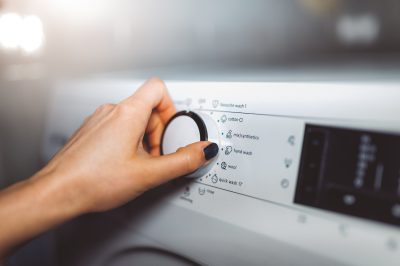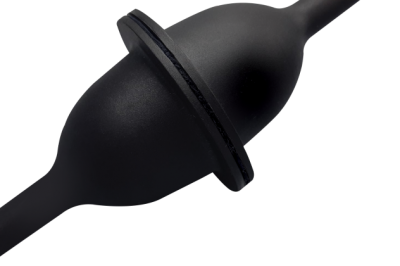公司最新动态
盐酸HCL
-
盐酸(hydrochloric acid [1] )是氯化氢(HCl)的水溶液 [2] ,属于一元无机强酸,工业用途广泛。盐酸的性状为无色透明的液体,有强烈的刺鼻气味,具有较高的腐蚀性。浓盐酸(质量分数约为37%)具有极强的挥发性,因此盛有浓盐酸的容器打开后氯化氢气体会挥发,与空气中的水蒸气结合产生盐酸小液滴,使瓶口上方出现酸雾。盐酸是胃酸的主要成分,它能够促进食物消化、抵御微生物感染。工业革命期间,盐酸开始大量生产。化学工业中,盐酸有许多重要应用,对产品的质量起决定性作用。盐酸可用于酸洗钢材 [5] ,也是大规模制备许多无机、有机化合物所需的化学试剂 [6-7] ,例如PVC塑料的前体氯乙烯。盐酸还有许多小规模的用途,比如用于家务清洁、生产明胶及其他食品添加剂、除水垢试剂、皮革加工。全球每年生产约两千万吨的盐酸。2017年10月27日,世界卫生组织国际癌症研究机构公布的致癌物清单初步整理参考,盐酸在三类致癌物清单中,即对人体致癌性的证据不充分。 [8]
- 中文名
- 盐酸
- 外文名
- hydrochloric acid
- 别 名
- 氢氯酸
- 化学式
- HCl
- 分子量
- 36.5
- CAS登录号
- 7647-01-0
- EINECS登录号
- 231-595-7
- 熔 点
- -27.32℃(247K,38%溶液)
- 沸 点
- 110℃(383K,20.2%溶液);48℃(321K,38%溶液)
- 水溶性
- 混溶
- 密 度
- 1.18 g/cm³
- 外 观
- 无色至淡黄色清澈液体
- 闪 点
- 不可燃
- 应 用
- 提取精盐等
- 危险性符号
- 腐蚀品
- 危险性描述
- 有腐蚀性
- UN危险货物编号
- 1789
- 属 于
- 一元无机强酸
- ATC代码
- A09AB03、B05XA13
- 酸度系数
- -8.0
- 黏 度
- 1.9 mPa·s(25℃,31.5%溶液)
- 警示术语
- R:R34, R37
- 安全术语
- S:S1/2, S26, S45
- 欧盟编号
- 017-002-01-X
- 主要危害
- 腐蚀性、刺激性
研究简史
人们对盐酸的认识最早来自于王水,是一种由盐酸与硝酸组成的混合物。13世纪欧洲炼金术士伪贾比尔的作品中提到,可以通过将卤砂(主要成分为氯化铵)溶于硝酸来制备王水 [9-12] 。也有说法称最先在手稿中提到王水的是13世纪末的拜占庭 [13] 。16世纪,利巴菲乌斯第一次正式记载了分离出的纯净盐酸,他是在粘土坩埚中加热盐与浓硫酸的混合物来制备氯化氢。也有一些作者认为纯的盐酸是由15世纪德国本笃会的巴希尔·瓦伦丁制备的 [14] ,他的方法是将食盐与硫酸亚铁混合加热后酸化 [15] 。不过,其他一些作者认为直到16世纪末都没有文献明确表明有人制备过纯的盐酸 [4] 。17世纪,德国卡尔施塔特县的约翰·格劳勃通过曼海姆法加热氯化钠和硫酸来制备硫酸钠,并释放出了氯化氢气体。1772年英国利兹的约瑟夫·普利斯特里制出了纯的氯化氢气体。1808年,英国彭赞斯的汉弗里·戴维证明了氯化氢气体由氢、氯两种元素组成 [16] 。工业革命期间,欧洲对碱的需求有所增加。法国伊苏丹的尼古拉斯·勒布朗新发现了一种碳酸钠(苏打)工业制法,使碳酸钠得以大规模廉价生产。勒布朗制碱法用硫酸、石灰石、煤将食盐转变为苏打,同时生成副产物氯化氢气体。这些氯化氢大多排放到空气中,直到各国出台相关法规(例如英国《1863年碱类法令》)后,苏打生产商们才用水吸收氯化氢,使得盐酸在工业上大量生产。 [17]20世纪,无盐酸副产物的氨碱法已经完全取代勒布朗法。这时盐酸已成为许多化工应用中很重要的一种化学品,因而人们开发了许多其他的制备方法,其中一些仍在使用。2000年后,绝大部分盐酸都是由工业生产有机物得到的副产品氯化氢溶于水而得到的。 [17] [18]理化性质
物理性质
盐酸是无色液体(工业用盐酸会因有杂质三价铁盐而略显黄色),为氯化氢的水溶液,具有刺激性气味,。由于浓盐酸具有挥发性,挥发出的氯化氢气体与空气中的水蒸气作用形成盐酸小液滴,所以会看到白雾。盐酸与水、乙醇任意混溶,氯化氢能溶于许多有机溶剂。浓盐酸稀释有热量放出。20℃时不同浓度盐酸的物理性质数据:质量分数浓度(g/L)密度(kg/L)物质的量浓度(mol/L)哈米特酸度函数粘性(m·Pa·s)比热容[KJ/(Kg·℃)]蒸汽压(Pa)沸点(℃)熔点(℃)10%104.801.0482.87-0.51.163.470.527103-1820%219.601.0986.02-0.81.372.9927.3108-5930%344.701.1499.45-1.01.702.60141090-5232%370.881.15910.17-1.01.802.55313084-4334%397.461.16910.90-1.01.902.50673371-3636%424.441.17911.64-1.11.992.461410061-3038%451.821.18912.39-1.12.102.432800048-26参考文献: [20]如下图所示,盐酸共有四个结晶的共熔点,分别对应四种晶体:68%(HCl的质量分数,下同)时的HCl·H2O、51%时的HCl·2H2O、41%时的HCl·3H2O和25%时的HCl·6H2O。另外在24.8%时还有一种亚稳的HCl·3H2O生成。 [21]盐酸在一定压力下能形成共沸溶液。下图为一个大气压下不同浓度盐酸的沸点,其中下方的线与上方的线分别表示相应温度下,液体及与液体处于平衡状态的蒸气的组分。氯化氢的质量分数20.24%对应最高沸点108.6℃。 [22]化学性质
酸性盐酸溶于碱液时与碱液发生中和反应。盐酸可以与氢氧化钠酸碱中和,产生食盐:一元酸只有一个酸离解常数,符号为Ka。它能够度量水溶液中酸的强度。于盐酸等强酸而言,Ka很大,只能通过理论计算来求得。向盐酸溶液中加入氯化物(比如NaCl)时pH基本不变,这是因为Cl–是盐酸的共轭碱,强度极弱。所以在计算时,若不考虑极稀的溶液,可以假设氢离子的物质的量浓度与原氯化氢浓度相同。如此做即使精确到四位有效数字都不会有误差。 [23] [24]还原性盐酸具有还原性,可以和一些强氧化剂反应,放出氯气:二氧化锰:二氧化铅:配位性铜在无空气时难溶于稀盐酸,但其能溶于热浓盐酸中,放出氢气: [22]有机化学酸性环境下可对醇类进行亲核取代生成卤代烃:氯化氢也可以加成烯双键得到氯代烃,例如:胺类化合物通常在水中溶解度不大。欲增大其溶解度,可以用稀盐酸处理为铵盐:利用这样的性质,可以将胺与其他有机化合物分离 [25] 。此外,胺的盐酸盐的熔点或分解点可以用来测定胺的种类。 [25]但应注意,此法只适用于对酸稳定的化合物,如果有α、β-碳碳双键等也会被还原: [6]制备方法
工业制法
电解法工业制备盐酸主要采用电解法。3、氯化氢气体冷却后被水吸收成为盐酸。在氯气和氢气的反应过程中,有毒的氯气被过量的氢气所包围,使氯气得到充分反应,防止了对空气的污染的同时避免了爆炸风险。在生产上,往往采取使另一种原料过量的方法使有害的、价格较昂贵的原料充分反应。 [26]有机反应副产物实验室制法
应用领域
生活用途
-
生物用途
人类和其他动物的胃壁上有一种特殊的腺体,能把吃下去的食盐变成盐酸。盐酸是胃液的一种成分(浓度约为0.5%),它能使胃液保持激活胃蛋白酶所需要的最适合的pH值,它还能使食盐中的蛋白质变性而易于水解,以及杀死随食物进入胃里的细菌的作用。此外,盐酸进入小肠后,可促进胰液、肠液的分泌以及胆汁的分泌和排放,酸性环境还有助于小肠内铁和钙的吸收。 [1]-
日常用途
工业用途
盐酸是一种无机强酸,在工业加工中有着广泛的应用,例如金属的精炼。盐酸往往能够决定产品的质量。分析化学在分析化学中,用酸来测定碱的浓度时,一般都用盐酸来滴定。用强酸滴定可使终点更明显,从而得到的结果更精确。在1标准大气压下,20.2%的盐酸可组成恒沸溶液,常用作一定气压下定量分析中的基准物。其恒沸时的浓度会随着气压的改变而改变。 [28]酸洗钢材酸洗钢材工业发展了盐酸再生工艺,如喷雾焙烧炉或流化床盐酸再生工艺等。这些工艺能让氯化氢气体从酸洗液中再生。其中最常见的是高温水解工艺,其反应方程式如下:将制得的氯化氢气体溶于水即又得到盐酸。通过对废酸的回收,人们建立了一个封闭的酸循环。副产品氧化铁在各种工业加工流程中也有较多应用。 [5] [29]制备有机化合物盐酸的另一大主要用途是制备有机化合物,例如合成PVC塑料的原料氯乙烯、二氯乙烷、聚碳酸酯的前体双酚A、催化胶黏剂聚乙烯醇缩甲醛、抗坏血酸等。企业合成PVC时通常不用市售的,而使用内部制备的盐酸。盐酸在制药方面也有很大的用途。 [6]如制备氯乙烯的反应:
制备无机化合物(用赤铁矿制备氯化铁)(用石灰石制备氯化钙)控制pH及中和碱液盐酸可以用来调节溶液的pH值:在工业中对纯度的要求极高时(如用于食品、制药及饮用水等),常用高纯的盐酸来调节水流的pH;要求相对不高时,工业纯的盐酸已足以中和废水,或处理游泳池中的水。 [29]用于焰色反应用于检验金属或它们的化合物时常使用焰色反应,用于检验的铂丝需用稀盐酸洗净以除去杂质元素的影响。检验物质前,应将铂丝用盐酸清洗,再放到火焰上灼烧,直到火焰呈原来颜色方可实验。 [31]阳离子交换树脂的再生高质量的盐酸常用于阳离子交换树脂的再生。阳离子交换广泛用于纯净水生产中,除去溶液中含有的Na+ 、 Ca2+等离子,而盐酸可以冲掉反应后树脂中的这些离子。一个H+ 替换一个Na+ ,Ca2+ 则需要两个
。
离子交换树脂和软化水在几乎所有的化学工业中都有应用,尤其是饮用水生产和食品工业。 [5]其他应用安全措施
健康危害
氯化氢的危险性取决于其浓度。下表中列出欧盟对盐酸溶液的分类。浓度分类 [34]警示术语10-25%刺激性 (Xi)R36/37/38> 25%腐蚀性 (C)R34R37危害防治
操作事项使用盐酸时,应配合个人防护装备。如橡胶手套或聚氯乙烯手套、护目镜、耐化学品的衣物和鞋子等,以降低直接接触盐酸所带来的危险。密闭操作,注意通风。操作尽可能机械化、自动化。操作人员必须经过专门培训,严格遵守操作规程。建议操作人员佩戴自吸过滤式防毒面具(全面罩),穿橡胶耐酸碱服,戴橡胶耐酸碱手套。远离易燃、可燃物。防止蒸气泄漏到工作场所空气中。避免与碱类、胺类、碱金属接触。搬运时要轻装轻卸,防止包装及容器损坏。配备泄漏应急处理设备。倒空的容器可能残留有害物。 [35]酸雾处理泄漏应急处理大量泄漏:构筑围堤或挖坑收容。用泵转移至槽车或专用收集器内,回收或运至废物处理场所处置。 [35]消防措施危险特性:能与一些活性金属粉末发生反应, 放出氢气。遇氰化物能产生剧毒的氰化氢气体。与碱发生中和反应,并放出大量的热。具有较强的腐蚀性。急救措施皮肤接触:立即脱去污染的衣着,用大量流动清水冲洗至少15分钟,可涂抹弱碱性物质(如碱水、肥皂水等),就医。食入:用大量水漱口,吞服大量生鸡蛋清或牛奶(禁止服用小苏打等药品),就医。 [35]安全标志
检测方法
方法名称应用范围本方法采用滴定法测定盐酸中氯化氢的含量。本方法适用于盐酸。
方法原理供试品用水稀释,加甲基红指示液,用氢氧化钠滴定液滴定。甲基红指示液变红时停止滴定,读出氢氧化钠滴定液使用量,计算盐酸含量。试剂1、蒸馏水(新沸放冷)2、氢氧化钠滴定液(1mol/L)3、甲基红指示液4、基准邻苯二甲酸氢钾试样制备1. 氢氧化钠滴定液(1mol/L)配制:取澄清的氢氧化钠饱和溶液56mL,加新沸过的冷水使成1000mL。标定:取在105℃干燥至恒重的基准邻苯二甲酸氢钾约6g,精密称定,加新沸过的冷水50mL,振摇,使其尽量溶解;加酚酞指示液2滴,用本液滴定,在接近终点时,应使邻苯二甲酸氢钾完全溶解,滴定至溶液显粉红色。每1mL氢氧化钠滴定液(1mol/L)相当于204.2mg的邻苯二甲酸氢钾。根据本液的消耗量与邻苯二甲酸氢钾的取用量,算出本液的浓度。贮藏:置聚乙烯塑料瓶中,密封保存;塞中有2孔,孔内各插入玻璃管1支,1管与钠石灰管相连,1管供吸出本液使用。2. 甲基红指示液取甲基红0.1g,加0.05mol/L氢氧化钠溶液7.4mL使溶解,再加水稀释至200mL,即得。操作步骤取该品约3mL,置贮有水20mL并称定重量的具塞锥形瓶中,精密称定,加甲基红指示液2滴,用氢氧化钠滴定液(1mol/L)滴定,每1mL氢氧化钠滴定液(1mol/L)相当于36.46mg的HCl。注:“精密称取”系指称取重量应准确至所称取重量的千分之一,“精密量取”系指量取体积的准确度应符合国家标准中对该体积移液管的精度要求。 [36]储存运输
储存方法
储存于阴凉、通风的库房。库温不超过30℃,相对湿度不超过85%。保持容器密封。应与碱类、胺类、碱金属、易(可)燃物分开存放,切忌混储。储区应备有泄漏应急处理设备和合适的收容材料。盐酸的联合国危险货物编号是1789,在装它的容器上需要注明这个编号。 [37]废弃处置方法: 用碱液-石灰水中和,生成氯化钠和氯化钙,用水稀释后排入废水系统。运输方法
危险货物编号: 81013UN编号: 1789包装类别: O52包装方法:耐酸坛或陶瓷瓶外普通木箱或半花格木箱;玻璃瓶或塑料桶(罐)外普通木箱或半花格木箱;磨砂口玻璃瓶或螺纹口玻璃瓶外普通木箱;螺纹口玻璃瓶、铁盖压口玻璃瓶、塑料瓶或金属桶(罐)外普通木箱。运输注意事项: 本品铁路运输时限使用有像胶衬里钢制罐车或特制塑料企业自备罐车装运,装运前需报有关部门批准。铁路运输时应严格按照铁道部《危险货物运输规则》中的危险货物配装表进行配装。起运时包装要完整,装载应稳妥。运输过程中要确保容器不泄漏、不倒塌、不坠落、不损坏。严禁与碱类、胺类、碱金属、易燃物或可燃物、食用化学品等混装混运。运输时运输车辆应配备泄漏应急处理设备。运输途中应防曝晒、雨淋,防高温。公路运输时要按规定路线行驶,勿在居民区和人口稠密区停留。 [1]
化学品安全技术说明书
| 产品名称: 盐酸 | 按照GB/T 16483、GB/T 17519 编制 |
| 修订日期: 2017年08月19日 | 最初编制日期: 2017年08月19日 |
| 版本: 1.0 |
第1部分 化学品及企业标识
- 化学品中文名:
- 盐酸
- 化学品英文名:
- hydrogen chloride
- -(24h)
- 产品推荐及限制用途:
- For industry use only.。
第2部分 危险性概述
- 紧急情况概述:
-
无资料
- GHS危险性类别:
- 无资料
- 标签要素:
-
- 象形图:
- 无资料
- 警示词:
- 无资料
- 危险性说明:
- 无资料
- 防范说明:
-
- 预防措施:
- 无资料
- 事故响应:
- 无资料
- 安全储存:
- 无资料
- 废弃处置:
- 无资料
- 预防措施:
- 物理和化学危险:
- 无资料
- 健康危害:
- 无资料
- 环境危害:
- 无资料
第3部分 成分/组成信息
| 组分 | 浓度或浓度范围(质量分数,%) | CAS No. |
|---|---|---|
| hydrogen chloride | 100% | 7647-01-0 |
第4部分 急救措施
- 急 救:
- 吸 入: 如果吸入,请将患者移到新鲜空气处。
皮肤接触: 脱去污染的衣着,用肥皂水和清水彻底冲洗皮肤。如有不适感,就医。
眼晴接触: 分开眼睑,用流动清水或生理盐水冲洗。立即就医。
食 入: 漱口,禁止催吐。立即就医。
- 对保护施救者的忠告:
- 将患者转移到安全的场所。咨询医生。出示此化学品安全技术说明书给到现场的医生看。
- 对医生的特别提示:
- 无资料。
第5部分 消防措施
- 灭火剂:
- 用水雾、干粉、泡沫或二氧化碳灭火剂灭火。
避免使用直流水灭火,直流水可能导致可燃性液体的飞溅,使火势扩散。
- 特别危险性:
- 无资料。
- 灭火注意事项及防护措施:
- 消防人员须佩戴携气式呼吸器,穿全身消防服,在上风向灭火。
尽可能将容器从火场移至空旷处。
处在火场中的容器若已变色或从安全泄压装置中发出声音,必须马上撤离。
隔离事故现场,禁止无关人员进入。收容和处理消防水,防止污染环境。
第6部分 泄露应急处理
- 作业人员防护措施、防护装备和应急处置程序:
- 建议应急处理人员戴携气式呼吸器,穿防静电服,戴橡胶耐油手套。
禁止接触或跨越泄漏物。
作业时使用的所有设备应接地。
尽可能切断泄漏源。
消除所有点火源。
根据液体流动、蒸汽或粉尘扩散的影响区域划定警戒区,无关人员从侧风、上风向撤离至安全区。
- 环境保护措施:
- 收容泄漏物,避免污染环境。防止泄漏物进入下水道、地表水和地下水。
- 泄漏化学品的收容、清除方法及所使用的处置材料:
- 小量泄漏:尽可能将泄漏液体收集在可密闭的容器中。用沙土、活性炭或其它惰性材料吸收,并转移至安全场所。禁止冲入下水道。
大量泄漏:构筑围堤或挖坑收容。封闭排水管道。用泡沫覆盖,抑制蒸发。用防爆泵转移至槽车或专用收集器内,回收或运至废物处理场所处置。
第7部分 操作处置与储存
- 操作注意事项:
- 操作人员应经过专门培训,严格遵守操作规程。
操作处置应在具备局部通风或全面通风换气设施的场所进行。
避免眼和皮肤的接触,避免吸入蒸汽。
个体防护措施参见第8部分。
远离火种、热源,工作场所严禁吸烟。
使用防爆型的通风系统和设备。
如需罐装,应控制流速,且有接地装置,防止静电积聚。
避免与氧化剂等禁配物接触(禁配物参见第10部分)。
搬运时要轻装轻卸,防止包装及容器损坏。
倒空的容器可能残留有害物。
使用后洗手,禁止在工作场所进饮食。
配备相应品种和数量的消防器材及泄漏应急处理设备。
- 储存注意事项:
- 储存于阴凉、通风的库房。
库温不宜超过37°C。
应与氧化剂、食用化学品分开存放,切忌混储(禁配物参见第10部分)。
保持容器密封。
远离火种、热源。
库房必须安装避雷设备。
排风系统应设有导除静电的接地装置。
采用防爆型照明、通风设置。
禁止使用易产生火花的设备和工具。
储区应备有泄漏应急处理设备和合适的收容材料。
第8部分 接触控制/个体防护
- 职业接触限值:
-
组分名称 CAS 标准来源 类型 标准值 备注 hydrogen chloride 7647-01-0 GBZ 2.1——2007 MAC 7.5 mg/m3 PC-TWA – PC-STEL – - 生物限制:
- 无资料
- 监测方法:
- GBZ/T 160.1 ~ GBZ/T 160.81-2004 工作场所空气有毒物质测定(系列标准), EN 14042 工作场所空气 用于评估暴露于化学或生物试剂的程序指南
- 工程控制:
- 作业场所建议与其它作业场所分开。
密闭操作,防止泄漏。
加强通风。
设置自动报警装置和事故通风设施。
设置应急撤离通道和必要的泻险区。
设置红色区域警示线、警示标识和中文警示说明,并设置通讯报警系统。
提供安全淋浴和洗眼设备。
- 个体防护装备:
- 呼吸系统防护:空气中浓度超标时,佩戴过滤式防毒面具(半面罩)。紧急事态抢救或撤离时,应该佩戴携气式呼吸器。
手防护:戴橡胶耐油手套。
眼睛防护:戴化学安全防护眼睛。
皮肤和身体防护:穿防毒物渗透工作服。
第9部分 理化特性
| 外观与性状:一种无色气体带有一种强烈的,辛辣气味 | 气味:无资料 |
| pH值:无资料 | 熔点/凝固点(°C):-35 °C |
| 沸点、初沸点和沸程(°C):57 °C | 自燃温度(°C):无资料 |
| 闪点(°C):88°C(lit.) | 分解温度(°C):无资料 |
| 爆炸极限[%(体积分数)]:无资料 | 蒸发速率[乙酸(正)丁酯以1计]:无资料 |
| 饱合蒸气压(kPa):613 psi ( 21.1 °C) | 易燃性(固体、气体):无资料 |
| 相对密度(水以1计):1.2?g/mL?at 25?°C(lit.) | 蒸气密度(空气以1计):1.3 (vs air) |
| 气味阈值(mg/m3):无资料 | n-辛醇/水分配系数(lg P):无资料 |
| 溶解性:水溶性:miscible。 | 黏度:无资料 |
第10部分 稳定性和反应性
- 稳定性:
- 正常环境温度下储存和使用,本品稳定。
- 危险反应:
- 无资料。
- 避免接触的条件:
- 静电放电、热、潮湿等。
- 禁配物:
- 强氧化物,强酸,强碱。
- 危险的分解产物:
- 无资料。
第11部分 毒理学信息
- 急性毒性:
- 经口: LD50 Rabbit oral 900 mg/kg
吸入: LC50 Rat inhalation 3124 ppm/1 hr
经皮: 无资料
- 皮肤刺激或腐蚀:
- 无资料。
- 眼睛刺激或腐蚀:
- 无资料。
- 呼吸或皮肤过敏:
- 无资料。
- 生殖细胞突变性:
- 无资料。
- 致癌性:
- 无资料。
- 生殖毒性:
- 无资料。
- 特异性靶器官系统毒性——一次接触:
- 无资料。
- 特异性靶器官系统毒性——反复接触:
- 无资料。
- 吸入危害:
- 无资料。
第12部分 生态学信息
- 生态毒性:
- 鱼类急性毒性试验: LC50; Species: Lepomis macrochirus (Blue gill); Conditions: artificial water, flow-through, 20 +/ -1 °C, dissolved oxygen 5-9 mg/L; Concentration: 24.6 mg/L for 96 hr for small and medium size fish; 30.9 mg/L for 96 hr for large size fish.
溞类急性活动抑制试验:无资料。
藻类生长抑制试验:无资料。
对微生物的毒性: 无资料。
- 持久性和降解性:
- 无资料。
- 生物富集或生物积累性:
- 无资料。
- 土壤中的迁移性:
- 无资料。
第13部分 废弃处置
- 废弃化学品:
- 尽可能回收利用。
如果不能回收利用,采用焚烧方法进行处置。
不得采用排放到下水道的方式废 弃处置本品。
- 污染包装物:
- 将容器返还生产商或按照国家和地方法规处置。
- 废弃注意事项:
- 废弃处置前应参阅国家和地方有关法规。
处置人员的安全防范措施参见第8部分。
第14部分 运输信息
- 联合国编号危险货物编号(UN号):
- UN1789
- 联合国运输名称:
- HYDROCHLORIC ACID
- 联合国危险性分类:
- 8
- 包装类别:
- III
- 包装方法:
- 按照生产商推荐的方法进行包装,例如:开口钢桶。安瓿瓶外普通木箱。螺纹口玻璃瓶、铁盖压口玻璃瓶、塑料瓶或金属桶(罐)外普通木箱等。
- 海洋污染物(是/否):
- 否
- 运输注意事项:
- 运输车辆应配备相应品种和数量的消防器材及泄漏应急处理设备。
严禁与氧化剂、食用化学品等混装混运。
装运该物品的车辆排气管必须配备阻火装置。
使用槽(罐)车运输时应有接地链,槽内可设孔隔板以减少震荡产生静电。
禁止使用易产生火花的机械设备和工具装卸。
夏季最好早晚运输。
运输途中应防暴晒、雨淋,防高温。
中途停留时应远离火种、热源、高温区。
公路运输时要按规定路线行驶,勿在居民区和人口稠密区停留。
铁路运输时要禁止溜放。
严禁用木船、水泥船散装运输。
运输工具上应根据相关运输要求张贴危险标志、公告。
第15部分 法规信息
下列法律、法规、规章和标准,对该化学品的管理作相应的规定:
组分 hydrogen chloride CAS: 7647-01-0
- 中华人民共和国职业病防止法:
- 职业病危害因素分类目录(2015): 列入
- 危险化学品安全管理条例:
- 危险品化学品目录(2015): 列入
易制爆危险化学品名录(2017): 未列入
- 重点监管的危险化学品名录:
- 首批和第二批重点监管的危险化学品名录: 未列入
- 危险化学品环境管理登记办法(试行):
- 重点环境管理危险化学品目录: 未列入
- 麻醉药品和精神药品管理条例:
- 麻醉药品品种目录: 未列入
精神药品品种目录: 未列入
- 新化学物质环境管理办法:
- 中国现有化学物质名录(2013): 列入
第16部分 其他信息
- 编写和修订信息:
- 本版为第1.0版,按照GB/T 16483-2008、GB/T 17519-2013、GB 30000系列分类标准编制。
- 参考文献:
- 【1】国际化学品安全规划署:国际化学品安全卡(ICSC),网址:http://www.ilo.org/dyn/icsc/showcard.home。
【2】国际癌症研究机构,网址:http://www.iarc.fr/。
【3】OECD 全球化学品信息平台,网址:http://www.echemportal.org/echemportal/index?pageID=0&request_locale=en。
【4】美国 CAMEO 化学物质数据库,网址:http://cameochemicals.noaa.gov/search/simple。
【5】美国医学图书馆:化学品标识数据库,网址:http://chem.sis.nlm.nih.gov/chemidplus/chemidlite.jsp。
【6】美国环境保护署:综合危险性信息系统,网址:http://cfpub.epa.gov/iris/。
【7】美国交通部:应急响应指南,网址:http://www.phmsa.dot.gov/hazmat/library/erg。
【8】德国GESTIS-有害物质数据库,网址:http://gestis-en.itrust.de/。
- 缩略语和首字母缩写:
- MAC:最高容许浓度(maximum allowable concentration),指工作地点、在一个工作日内、任何时间有毒化学物质均不应超过的浓度。
PC-TWA:时间加权平均容许浓度(permissible concentration-time weighted average),指以时间为权数规定的8 h工作日、40 h工作周的平均容许接触浓度。
PC-STEL:短时间接触容许浓度(permissible concentration-short term exposure limit),指在遵守PC-TWA前提下允许短时间(15 min)接触的浓度。
- 免责声明:
- 本SDS的信息仅适用于所指定的产品,除非特别指明,对于本产品与其它物质的混合物等情况不适用。本SDS只为那些受过适当专业训练的该产品的使用人员提供产品使用安全方面的资料。本SDS的使用者,须对该SDS的适用性作出独立判断。由于使用本SDS所导致的伤害,本SDS的编写者将不负任何责任。
SAFETY DATA SHEETS
According to Globally Harmonized System of Classification and Labelling of Chemicals (GHS) – Sixth revised edition
Version: 1.0
Creation Date: Aug 12, 2017
Revision Date: Aug 12, 2017
1.Identification
1.1GHS Product identifier
| Product name | hydrogen chloride |
|---|
1.2Other means of identification
| Product number | – |
|---|---|
| Other names | HCL |
1.3Recommended use of the chemical and restrictions on use
| Identified uses | For industry use only. Inorganic substances |
|---|---|
| Uses advised against | no data available |
1.4Supplier’s details
1.5Emergency phone number
| Emergency phone number | – |
|---|---|
| Service hours | Monday to Friday, 9am-5pm (Standard time zone: UTC/GMT +8 hours). |
2.Hazard identification
2.1Classification of the substance or mixture
no data available
2.2GHS label elements, including precautionary statements
| Pictogram(s) | no data available |
|---|---|
| Signal word | no data available |
| Hazard statement(s) | no data available |
| Precautionary statement(s) | |
| Prevention | no data available |
| Response | no data available |
| Storage | no data available |
| Disposal | no data available |
2.3Other hazards which do not result in classification
no data available
3.Composition/information on ingredients
3.1Substances
| Chemical name | Common names and synonyms | CAS number | EC number | Concentration |
|---|---|---|---|---|
| hydrogen chloride | hydrogen chloride | 7647-01-0 | none | 100% |
4.First-aid measures
4.1Description of necessary first-aid measures
General advice
Consult a physician. Show this safety data sheet to the doctor in attendance.
If inhaled
Fresh air, rest. Half-upright position. Artificial respiration may be needed. Refer immediately for medical attention.
In case of skin contact
Wear protective gloves when administering first aid. First rinse with plenty of water for at least 15 minutes, then remove contaminated clothes and rinse again. Refer immediately for medical attention.
In case of eye contact
Rinse with plenty of water for several minutes (remove contact lenses if easily possible). Refer immediately for medical attention.
If swallowed
Never give anything by mouth to an unconscious person. Rinse mouth with water. Consult a physician.
4.2Most important symptoms/effects, acute and delayed
Inhalation of fumes results in coughing and choking sensation, and irritation of nose and lungs. Liquid causes burns. (USCG, 1999)
Gas concentrations of 50 to 100 ppm are tolerable for 1 hour. Concentrations of 1,000 to 2,000 ppm are dangerous, even for brief exposures. More severe exposures will result in serious respiratory distress and prolonged exposures will result in death. Mists of hydrochloric acid are considered less harmful than anhydrous hydrochloric acid, because droplets have no dehydrating action. Individuals with respiratory problems and digestive diseases may be adversely affected by low level exposures to the gas or mist. (EPA, 1998)
Excerpt from ERG Guide 125 [Gases – Corrosive]: TOXIC; may be fatal if inhaled, ingested or absorbed through skin. Vapors are extremely irritating and corrosive. Contact with gas or liquefied gas may cause burns, severe injury and/or frostbite. Fire will produce irritating, corrosive and/or toxic gases. Runoff from fire control may cause pollution. (ERG, 2016)
SYMPTOMS: Symptoms of exposure to this compound include mild irritation of the skin and eyes, diarrhea and gastrointestinal irritation. It may also cause nausea, pulmonary edema and coma. Gastrointestinal disturbances may occur. ACUTE/CHRONIC HAZARDS: This compound is a mild irritant of the skin and eyes. When heated to decomposition it emits toxic fumes of nitrogen oxides, sulfur oxides and ammonia.
4.3Indication of immediate medical attention and special treatment needed, if necessary
/PREHOSPITAL/ Consult with the base station physician or the regional poison control center for advice regarding triage of multiple victims. Patients with evidence of significant exposure such as skin or eye irritation, pain, or breathing difficulties should be transported to a medical facility for evaluation. Others may be discharged from the scene after their names, addresses, and telephone numbers are recorded. Those discharged should be advised to seek medical care promptly if symptoms develop
5.Fire-fighting measures
5.1Extinguishing media
Suitable extinguishing media
Suitable extinguishing media: Use water spray, alcohol-resistant foam, dry chemical or carbon dioxide.
5.2Specific hazards arising from the chemical
Special Hazards of Combustion Products: Toxic and irritating vapors are generated when heated. (USCG, 1999)
Fire may produce irritating or poisonous gases. Containers may explode in heat of fire. At high temperatures, it decomposes into hydrogen and chlorine. The following materials should be avoided: Mercuric sulfate — violent reaction with gaseous hydrochloric acid at 250F. Sodium — reacts vigorously with gaseous hydrochloric acid. Acetic anhydride, 2-aminoethanol, ammonium hydroxide, chlorosulfonic acid, ethylene diamine, ethyleneimine, oleum, propiolactone, sodium hydroxide, sulfuric acid, and vinyl acetate — increase in temperature and pressure when mixed with hydrochloric acid. Calcium phosphide — energetic reaction with hydrochloric acid. Silver perchlorate and carbon tetrachloride — when mixed in combination with hydrochloric acid forms a compound that detonates at 105F. Formaldehyde — when mixed with hydrochloric acid forms a human carcinogen. Material reacts violently with bases and is corrosive with the generation of heat. Reacts with base metals, forming combustible gas (hydrogen). Reacts violently with strong oxidants forming toxic gas (chlorine). Avoid heat; at high temperatures it will decompose into hydrogen and chlorine. (EPA, 1998)
Excerpt from ERG Guide 125 [Gases – Corrosive]: Some may burn but none ignite readily. Vapors from liquefied gas are initially heavier than air and spread along ground. Some of these materials may react violently with water. Cylinders exposed to fire may vent and release toxic and/or corrosive gas through pressure relief devices. Containers may explode when heated. Ruptured cylinders may rocket. For UN1005: Anhydrous ammonia, at high concentrations in confined spaces, presents a flammability risk if a source of ignition is introduced. (ERG, 2016)
This chemical is probably combustible.
5.3Special protective actions for fire-fighters
Wear self-contained breathing apparatus for firefighting if necessary.
6.Accidental release measures
6.1Personal precautions, protective equipment and emergency procedures
Use personal protective equipment. Avoid dust formation. Avoid breathing vapours, mist or gas. Ensure adequate ventilation. Evacuate personnel to safe areas. Avoid breathing dust. For personal protection see section 8.
6.2Environmental precautions
Evacuate danger area! Consult an expert! Personal protection: gas-tight chemical protection suit including self-contained breathing apparatus. Ventilation. Remove gas with fine water spray.
6.3Methods and materials for containment and cleaning up
Accidental release measures. Personal precautions, protective equipment and emergency procedures: Wear respiratory protection. Avoid breathing vapors, mist or gas. Ensure adequate ventilation. Evacuate personnel to safe areas.; Environmental precautions: Prevent further leakage or spillage if safe to do so. Do not let product enter drains.; Methods and materials for containment and cleaning up: Clean up promptly by sweeping or vacuum.
7.Handling and storage
7.1Precautions for safe handling
Avoid contact with skin and eyes. Avoid formation of dust and aerosols. Avoid exposure – obtain special instructions before use.Provide appropriate exhaust ventilation at places where dust is formed. For precautions see section 2.2.
7.2Conditions for safe storage, including any incompatibilities
Cool. Fireproof if in building. Separated from food and feedstuffs and incompatible materials. See Chemical Dangers. Keep in a well-ventilated room.Keep container tightly closed in a dry and well-ventilated place. Storage class (TRGS 510): Gases
8.Exposure controls/personal protection
8.1Control parameters
Occupational Exposure limit values
Recommended Exposure Limit: Ceiling value: 5 ppm (7 mg/cu m).
Biological limit values
no data available
8.2Appropriate engineering controls
Handle in accordance with good industrial hygiene and safety practice. Wash hands before breaks and at the end of workday.
8.3Individual protection measures, such as personal protective equipment (PPE)
Eye/face protection
Safety glasses with side-shields conforming to EN166. Use equipment for eye protection tested and approved under appropriate government standards such as NIOSH (US) or EN 166(EU).
Skin protection
Wear impervious clothing. The type of protective equipment must be selected according to the concentration and amount of the dangerous substance at the specific workplace. Handle with gloves. Gloves must be inspected prior to use. Use proper glove removal technique(without touching glove’s outer surface) to avoid skin contact with this product. Dispose of contaminated gloves after use in accordance with applicable laws and good laboratory practices. Wash and dry hands. The selected protective gloves have to satisfy the specifications of EU Directive 89/686/EEC and the standard EN 374 derived from it.
Respiratory protection
Wear dust mask when handling large quantities.
Thermal hazards
no data available
9.Physical and chemical properties
| Physical state | A colorless gas with a sharp, pungent odor. |
|---|---|
| Colour | Colorless gas |
| Odour | Pungent, irritating odor |
| Melting point/ freezing point | -38°C(lit.) |
| Boiling point or initial boiling point and boiling range | 100°C(lit.) |
| Flammability | Nonflammable GasNot combustible. |
| Lower and upper explosion limit / flammability limit | no data available |
| Flash point | 17°C |
| Auto-ignition temperature | Not flammable (USCG, 1999) |
| Decomposition temperature | no data available |
| pH | no data available |
| Kinematic viscosity | 0.405 cP (liquid at 118.16 K); 0.0131 cP (vapor at 273.06 K); 0.0253 cP (vapor at 523.2 K) |
| Solubility | In water:miscible |
| Partition coefficient n-octanol/water (log value) | 0.25 |
| Vapour pressure | 613 psi ( 21.1 °C) |
| Density and/or relative density | 1.2g/mLat 25°C(lit.) |
| Relative vapour density | 1.3 (vs air) |
| Particle characteristics | no data available |
10.Stability and reactivity
10.1Reactivity
no data available
10.2Chemical stability
Stable under recommended storage conditions.
10.3Possibility of hazardous reactions
The gas is heavier than air and may accumulate in lowered spaces causing a deficiency of oxygen.HYDROCHLORIC ACID is an aqueous solution of hydrogen chloride, an acidic gas. Reacts exothermically with organic bases (amines, amides) and inorganic bases (oxides and hydroxides of metals). Reacts exothermically with carbonates (including limestone and building materials containing limestone) and hydrogen carbonates to generate carbon dioxide. Reacts with sulfides, carbides, borides, and phosphides to generate toxic or flammable gases. Reacts with many metals (including aluminum, zinc, calcium, magnesium, iron, tin and all of the alkali metals) to generate flammable hydrogen gas. Reacts violently with acetic anhydride, 2-aminoethanol, ammonium hydroxide, calcium phosphide, chlorosulfonic acid, 1,1-difluoroethylene, ethylenediamine, ethyleneimine, oleum, perchloric acid, b-propiolactone, propylene oxide, silver perchlorate/carbon tetrachloride mixture, sodium hydroxide, uranium(IV) phosphide, vinyl acetate, calcium carbide, rubidium carbide, cesium acetylide, rubidium acetylide, magnesium boride, mercury(II) sulfate [Lewis]. Mixtures with concentrated sulfuric acid can evolve toxic hydrogen chloride gas at a dangerous rate. Undergoes a very energetic reaction with calcium phosphide [Mellor 8:841(1946-1947)].
10.4Conditions to avoid
no data available
10.5Incompatible materials
The aqueous solution is a strong acid. Corrosive fumes emitted on contact with air. Reacts violently with bases, oxidizers forming toxic chlorine gas. Reacts, often violently, with acetic anhydride, active metals, aliphatic amines, alkanolamines, alkylene oxides, aromatic amines, amides, 2-aminoethanol, ammonia, ammonium hydroxide, calcium phosphide, chlorosulfonic acid, ethylene diamine, ethyleneimine, epichlorohydrin, isocyanates, metal acetylides, oleum, organic anhydrides, perchloric acid, 3-propiolactone, uranium phosphide, sulfuric acid, vinyl acetate, vinylidene fluoride. Highly corrosive to most metals, forming flammable hydrogen gas. Attacks some plastics, rubber, and coatings.
10.6Hazardous decomposition products
When heated to decomp it emits toxic fumes of Cl- /Hydrochloric acid/.
11.Toxicological information
Acute toxicity
- Oral: LD50 Rabbit oral 900 mg/kg
- Inhalation: LC50 Rat inhalation 3124 ppm/1 hr
- Dermal: no data available
Skin corrosion/irritation
no data available
Serious eye damage/irritation
no data available
Respiratory or skin sensitization
no data available
Germ cell mutagenicity
no data available
Carcinogenicity
Evaluation: There is inadequate evidence for the carcinogenicity in humans of hydrochloric acid. There is inadequate evidence for the carcinogenicity in experimental animals of hydrochloric acid. Overall evaluation: Hydrochloric acid is not classifiable as to its carcinogenicity to humans (Group 3).
Reproductive toxicity
No information is available on the reproductive or developmental effects of hydrochloric acid in humans. In rats exposed to hydrochloric acid by inhalation, severe dyspnea, cyanosis, and altered estrus cycles have been reported in dams, and increased fetal mortality and decreased fetal weight have been reported in the offspring.
STOT-single exposure
no data available
STOT-repeated exposure
no data available
Aspiration hazard
no data available
12.Ecological information
12.1Toxicity
- Toxicity to fish: LC50; Species: Lepomis macrochirus (Blue gill); Conditions: artificial water, flow-through, 20 +/ -1 °C, dissolved oxygen 5-9 mg/L; Concentration: 24.6 mg/L for 96 hr for small and medium size fish; 30.9 mg/L for 96 hr for large size fish.
- Toxicity to daphnia and other aquatic invertebrates: no data available
- Toxicity to algae: no data available
- Toxicity to microorganisms: no data available
12.2Persistence and degradability
no data available
12.3Bioaccumulative potential
Hydrogen chloride dissociates readily in water to chloride and hydronium ions(1). Therefore, hydrogen chloride does not accumulate in the aquatic organisms(1,2).
12.4Mobility in soil
Hydrogen chloride dissociates into chloride and hydronium ions in moist soil(1).
12.5Other adverse effects
no data available
13.Disposal considerations
13.1Disposal methods
Product
The material can be disposed of by removal to a licensed chemical destruction plant or by controlled incineration with flue gas scrubbing. Do not contaminate water, foodstuffs, feed or seed by storage or disposal. Do not discharge to sewer systems.
Contaminated packaging
Containers can be triply rinsed (or equivalent) and offered for recycling or reconditioning. Alternatively, the packaging can be punctured to make it unusable for other purposes and then be disposed of in a sanitary landfill. Controlled incineration with flue gas scrubbing is possible for combustible packaging materials.
14.Transport information
14.1UN Number
| ADR/RID: UN1789 | IMDG: UN1789 | IATA: UN1789 |
14.2UN Proper Shipping Name
| ADR/RID: HYDROCHLORIC ACID |
| IMDG: HYDROCHLORIC ACID |
| IATA: HYDROCHLORIC ACID |
14.3Transport hazard class(es)
| ADR/RID: 8 | IMDG: 8 | IATA: 8 |
14.4Packing group, if applicable
| ADR/RID: III | IMDG: III | IATA: III |
14.5Environmental hazards
| ADR/RID: no | IMDG: no | IATA: no |
14.6Special precautions for user
no data available
14.7Transport in bulk according to Annex II of MARPOL 73/78 and the IBC Code
no data available
15.Regulatory information
15.1Safety, health and environmental regulations specific for the product in question
| Chemical name | Common names and synonyms | CAS number | EC number |
|---|---|---|---|
| hydrogen chloride | hydrogen chloride | 7647-01-0 | none |
| European Inventory of Existing Commercial Chemical Substances (EINECS) | Listed. | ||
| EC Inventory | Listed. | ||
| United States Toxic Substances Control Act (TSCA) Inventory | Listed. | ||
| China Catalog of Hazardous chemicals 2015 | Listed. | ||
| New Zealand Inventory of Chemicals (NZIoC) | Listed. | ||
| Philippines Inventory of Chemicals and Chemical Substances (PICCS) | Listed. | ||
| Vietnam National Chemical Inventory | Listed. | ||
| Chinese Chemical Inventory of Existing Chemical Substances (China IECSC) | Listed. | ||
16.Other information
Information on revision
| Creation Date | Aug 12, 2017 |
|---|---|
| Revision Date | Aug 12, 2017 |
Abbreviations and acronyms
- CAS: Chemical Abstracts Service
- ADR: European Agreement concerning the International Carriage of Dangerous Goods by Road
- RID: Regulation concerning the International Carriage of Dangerous Goods by Rail
- IMDG: International Maritime Dangerous Goods
- IATA: International Air Transportation Association
- TWA: Time Weighted Average
- STEL: Short term exposure limit
- LC50: Lethal Concentration 50%
- LD50: Lethal Dose 50%
- EC50: Effective Concentration 50%
References
- IPCS – The International Chemical Safety Cards (ICSC), website: http://www.ilo.org/dyn/icsc/showcard.home
- HSDB – Hazardous Substances Data Bank, website: https://toxnet.nlm.nih.gov/newtoxnet/hsdb.htm
- IARC – International Agency for Research on Cancer, website: http://www.iarc.fr/
- eChemPortal – The Global Portal to Information on Chemical Substances by OECD, website: http://www.echemportal.org/echemportal/index?pageID=0&request_locale=en
- CAMEO Chemicals, website: http://cameochemicals.noaa.gov/search/simple
- ChemIDplus, website: http://chem.sis.nlm.nih.gov/chemidplus/chemidlite.jsp
- ERG – Emergency Response Guidebook by U.S. Department of Transportation, website: http://www.phmsa.dot.gov/hazmat/library/erg
- Germany GESTIS-database on hazard substance, website: http://www.dguv.de/ifa/gestis/gestis-stoffdatenbank/index-2.jsp
- ECHA – European Chemicals Agency, website: https://echa.europa.eu/
Disclaimer: The above information is believed to be correct but does not purport to be all inclusive and shall be used only as a guide. The information in this document is based on the present state of our knowledge and is applicable to the product with regard to appropriate safety precautions. It does not represent any guarantee of the properties of the product. We as supplier shall not be held liable for any damage resulting from handling or from contact with the above product.
NEXT: 硫酸H2SO4

















































